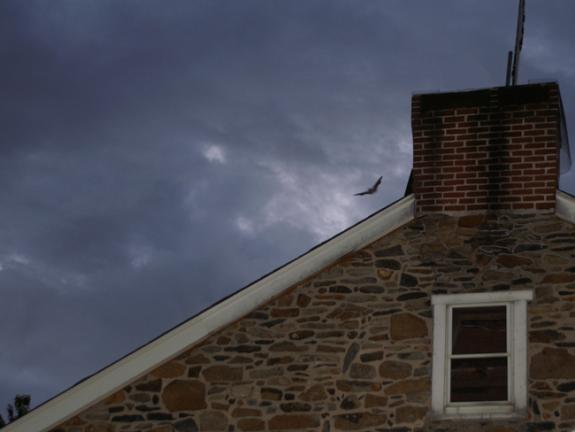Summer Bat Count
Got Bats? Help us keep tabs on New Jersey's bat populations.
 A bat emerges from its summer roost site. © MacKenzie Hall
A bat emerges from its summer roost site. © MacKenzie Hall
The Summer Bat Count was created in 2003 by the Conserve Wildlife Foundation and the state's Endangered and Nongame Species Program (ENSP). These data give us a better understanding of how NJ's bats are distributed, what conditions they choose for roosting, population estimates and changes overtime, and reproduction success.
This volunteer project relies on New Jersey residents to tell us where the bats are. So if you know of a place where bats roost in the summertime - like an attic, barn, bat house, church, or tree - then we'd love to hear from you!
Participating in the Bat Count
First, you have to know of a bat roost and be able to identify the bats' entry/exit points. Bats often find their way in and out of buildings through an opening in the eaves, a ridge vent into the attic, a gap in soffit boards where they join at the peak, or the space where the chimney meets the house's siding or eaves. Sometimes bats roost behind shutters or under roofing, too. Watch closely at dusk for their swooping silhouettes. You may even hear their mousey chatter as they get ready to depart.
We ask Summer Bat Counters to conduct four bat counts per summer - two between May 15 and June 21 (before pups can fly) and two more between July 6 and July 31 (when pups are flying and exiting the roost with their mothers). Making sure you do all four bat counts will allow us to best compare data from year to year and between sites and let us know if you need help counting.
The bat counts are pretty simple:
- Arrive at your bat roost by sunset time. Bats will begin to emerge 10-15 minutes later, at dusk.
- The air temperature should be at least 55 degrees (F), no rain, and with wind speeds below 15 mph.
- Sit or stand outside so that the bats' exit point is visible from a comfortable distance. More than one person might be needed if bats are exiting from multiple points.
- Don't shine a flashlight at the exit point - bats are shy and cautious and might not come out.
- Tally the bats as they fly out for their nightly insect-eating! Most will have left by the time it's totally dark outside. Record your observations on the data sheet.
- Mail us your data sheet at the end of the summer.
- Do not enter bat roosts or handle the animals.
- Please respect private property. Ask permission if the bat roost is on someone else's land.
If you know of a summer bat roost and would like to participate, please contact us or simply print and complete a Summer Bat Count data sheet.
Data sheets:
Reports:

2017 Mobile Acoustic & Summer Bat Count Report - 10.3MB
Report for CWF's 2017 Mobile Acoustic & Summer Bat Count projects.
2015 Summer Bat Count and Mobile Acoustics Report - 1.2MB
Similar story to last year, but a new roost has been discovered!
Learn More:
- Want to know more about your "house bats" or find out how to solve a bat problem? Visit our Bats in Buildings page.
Find Related Info: Bats







